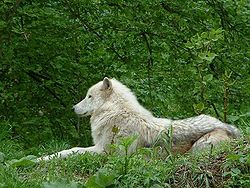
Canis lupus occidentalis
| Northern gray wolf |
|---|
 |
| Scientific Classification |
| Trinomial Name |
Canis lupus occidentalis |
The Northern Grey Wolf (Canis lupus occidentalis), also known as the Mackenzie grey wolf, is one of the largest wolves in North America. They can travel 30-70 miles in one day, which is mostly if they are hunting. When the wolves are just trotting around, they go around 5 mph, but in a full sprint they can go from 30-40 mph. Their fur can vary but is mostly black or white, depending on their location. Wolves usually live to be 6-8 years of age. These wolves can live in many kinds of habitats since they are easily adapted to nature around them, like forests, tundra, taiga, deserts, plains, and mountains. Their strategy for getting food is to prey on the young, old, and sick members of their prey so it is easier to take down Grey wolves love to be together in a pack and stay as a congregation. They all live in a den that is full of pups and adult wolves. These are very beautiful animals but should be just for looking.
The Northern Grey Wolf, Canis lupus occidentalis, also knows as the Mackenzie grey wolf, is much like the other wolves but have different characteristics. This wolf is one of the largest in North America. Male wolves can weight between 100 to 145 pounds in their adult stage and females weight 10 to 20 percent less than males.[1] The heaviest wolf on record was found in Alaska in 1939, and it weighed 175 pounds. The wolves’ measure from the ground to the shoulders is usually 32-36 inches while from the tip of the nose to the tip of the tail is on average 5-7 feet in length.[2] The skull is about 12 inches long. Their very powerful jaw can exert 1500 pounds per square inch and their strong neck muscles allow them to easily break bones and take down huge prey when hunting. Their mouth holds 42 teeth. There are 20 teeth in the upper jaw (six incisors, two canine, eight premolars, and four molars), and 22 teeth in the lower jaw (six incisors, two canine, eight premolars, and six molars).[3] The legs on a grey wolf are very muscular and allow them to travel for long periods of time and in deep snow or other terrains. They can travel 30-70 miles in one day, which is mostly if they are hunting something. When the wolves are just trotting around, they go around 5 mph, but in a full sprint they can go from 30-40 mph. Their fur can vary but are mostly black or white, it depends on there location. [4]
The life cycle of a grey wolf starts when a female and a male mate, usually happens between the months of January and April. Once the mating is over, the gestation begins. It lasts 63 days and after that 2-10 pups are born. The newborn pups stay in the cave/den for 2-4 weeks,or until 8-10 weeks old.[5] Everyone in the pack takes care of them. The sexually mature age for wolves is 2-3 years, old but usually the dominant, alpha male and female mate. Wolves usually live to be 6-8 years of age. If they are raised in a zoo, they can live up to the age of 17 years. [6]
The average size of the wolves is because their large diet of food. They will prey on wood bison, elk, caribou, musk ox, moose, Dall sheep, Sitka black-tailed deer, mountain goat, beaver, ground squirrel, vole, snowshoe hare, lemmings, and salmon. Their strategy is to prey on the young, old, and sick members of their prey so it is easier to take down. Whenever the wolves kill their food, they will eat all that they can possibly get. They can eat up to 20 pounds on one hunting trip. Beavers play a major part in the wolfs diet because they are easy to catch and eat. Some reported that gray wolves diets vary, on the preys size and numbers. Other prey species include mountain goats, bison, pronghorn, various rodents, upland game birds and waterfowl, snowshoe hare, and black bear were found in gray wolf scat sometimes gray wolves hunt domestic livestock. [9]
Usually whenever you see a wolf, there will be more wolves to follow. Grey wolves love to be together in a pack and stay as a congregation. They all live in a den that is full of pups and adult wolves. When they go out to hunt, they usually hunt in a pack of 6-10 wolves to take down a big animal. The whole pack can travel up to 12 miles or more per day. In the wolf pack there are two dominating wolves: the alpha male and the alpha female. They are the wolves that run the whole pack and mate and make more pups. Since the whole pack is sort of like a family whenever a wolf has a baby pup, the whole pack takes care of it. Being that the alphas mate, they don’t have that much time to raise a pup, so everyone helps out. They also keep the wolves safe and everyone is responsible to keep everyone else safe from harm.[10]
|
||||||||||||||||||||